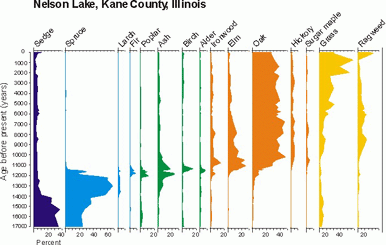
Current Interglacial - Coring the Lake
"When we core a lake, we look for more than just fossil pollen. Other fossils, charcoal, and sediment chemistry can also tell us about past environments and events. We use the radiocarbon method to date organic material in the layers to determine the timing of environmental changes."
Palynologists (scientists who study pollen) use a coring device to collect sediment from lakebeds. This work is often done in the winter when the lake is frozen. The ice will support people and their equipment. The corer removes sediment cores (long cylinders of mud) from the bottom.
Back in the lab, the cores are sliced into thin layers, and the samples are prepared to concentrate the pollen. We use a microscope to identify the pollen in each layer. The pollen shows which plants were growing in the area when the sediment was deposited.
Learn more about pollen studies here.Pollen Diagrams
A diagram of fossil pollen from Nelson Lake shows the change from cold-climate
plants at the end of the Ice Age to warm-climate plants. Because different
plant species produce different amounts of pollen, we cannot reconstruct
past habitats directly from fossil pollen percentages. We study pollen
samples from modern habitats where we can examine the relationship between
the percentages of pollen in our samples and the living vegetation. We
then compare the modern samples to the fossil samples for more clues.